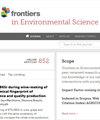A better strategy: using green GDP to measure economic health
IF 3.3
3区 环境科学与生态学
Q2 ENVIRONMENTAL SCIENCES
引用次数: 0
Abstract
IntroductionGross Domestic Product (GDP) is the most well-known and widely used measure of a country’s economic health. However, GDP fails to account for the depletion of natural resources and the environmental damage that occurs in the pursuit of economic growth, leading to an incomplete and potentially misleading picture of a nation’s well-being. To address this shortcoming, Green GDP (GGDP) is proposed as a more comprehensive indicator that incorporates environmental factors into the economic assessment. This study builds on extensive literature reviews, internationally accepted GGDP accounting methods, and scholarly research to propose a new GGDP calculation model that better reflects a country’s sustainable development.MethodsThe proposed GGDP model is divided into two main components: natural resource loss and environmental pollution loss. Each component is further broken down into primary factors that are condensed into 13 sub-criteria reflecting a country’s capacity for sustainable development. Principal Component Analysis (PCA) is utilized to identify the most representative factors from these sub-criteria and to analyze the relationships among GGDP, these factors, and global mean temperature. Additionally, the Integrated Environmental Sustainability Index (IESI) is used to develop a global temperature mitigation prediction model, which considers the impacts of epidemics, sea and land temperatures, and variations in climate across different regions.ResultsThe analysis shows a 74% probability that positive GGDP growth correlates with temperature changes over a 50-year period, indicating that economic activities measured by GGDP are linked to climate change. The GGDP model reveals significant differences between global GDP and Green GDP, with the latter growing at a much slower rate. This slower growth of Green GDP is primarily due to the declining share of GDP from natural resource-dependent activities, which has fallen from 90% in the 1970s to 80% in 2020. This trend underscores the increasing gap between traditional economic growth and sustainable development, suggesting that as countries continue to rely on natural resources, their overall ecological efficiency declines, environmental pressures increase, and the potential for long-term sustainable development diminishes.DiscussionThe findings demonstrate that all factors within the GGDP model are proportional to global temperature, underscoring the significant impact that natural resource utilization and pollution emissions have on economic growth and climate change. The study further evaluates global sustainable development by considering both economic and environmental perspectives. Using Brazil as a case study, the model is applied to assess the values of each component within the GGDP framework, providing a comprehensive analysis of the country’s sustainable development challenges and potential solutions. This approach establishes a method for assessing sustainable development that can be adapted for use in other countries, offering a path forward for integrating environmental considerations into economic policies.更好的战略:利用绿色 GDP 衡量经济健康状况
导言:国内生产总值(GDP)是衡量一个国家经济健康状况的最著名和最广泛使用的指标。然而,GDP 没有考虑到在追求经济增长的过程中对自然资源的损耗和对环境的破坏,导致对一个国家福祉的描述不全面,并可能产生误导。为了弥补这一缺陷,我们提出了绿色 GDP(GGDP)作为一个更全面的指标,将环境因素纳入经济评估。本研究在广泛的文献综述、国际公认的 GGDP 核算方法和学术研究的基础上,提出了一个新的 GGDP 计算模型,以更好地反映一个国家的可持续发展。每个组成部分又进一步细分为主要因素,并浓缩为 13 个次级标准,以反映一个国家的可持续发展能力。利用主成分分析法(PCA)从这些子标准中找出最具代表性的因素,并分析 GGDP、这些因素和全球平均气温之间的关系。此外,还利用综合环境可持续性指数 (IESI) 建立了全球气温减缓预测模型,该模型考虑了流行病、海陆温度以及不同地区气候差异的影响。结果分析表明,在 50 年的时间里,GGDP 的正增长与气温变化相关的概率为 74%,这表明以 GGDP 衡量的经济活动与气候变化有关。GGDP 模型揭示了全球 GDP 和绿色 GDP 之间的显著差异,后者的增长速度要慢得多。绿色 GDP 增长放缓的主要原因是依赖自然资源的活动在 GDP 中所占的份额不断下降,从 20 世纪 70 年代的 90%下降到 2020 年的 80%。这一趋势凸显了传统经济增长与可持续发展之间日益加大的差距,表明随着各国对自然资源的持续依赖,其整体生态效率下降,环境压力增大,长期可持续发展的潜力减弱。 讨论研究结果表明,GGDP 模型中的所有因素都与全球气温成正比,强调了自然资源利用和污染排放对经济增长和气候变化的重大影响。本研究从经济和环境两个角度对全球可持续发展进行了进一步评估。该模型以巴西为案例,用于评估全球可持续发展总值框架内各组成部分的价值,对该国的可持续发展挑战和潜在解决方案进行了全面分析。这种方法确立了一种评估可持续发展的方法,可适用于其他国家,为将环境因素纳入经济政策提供了前进的道路。
本文章由计算机程序翻译,如有差异,请以英文原文为准。
求助全文
约1分钟内获得全文
求助全文
来源期刊

Frontiers in Environmental Science
Environmental Science-General Environmental Science
CiteScore
4.50
自引率
8.70%
发文量
2276
审稿时长
12 weeks
期刊介绍:
Our natural world is experiencing a state of rapid change unprecedented in the presence of humans. The changes affect virtually all physical, chemical and biological systems on Earth. The interaction of these systems leads to tipping points, feedbacks and amplification of effects. In virtually all cases, the causes of environmental change can be traced to human activity through either direct interventions as a consequence of pollution, or through global warming from greenhouse case emissions. Well-formulated and internationally-relevant policies to mitigate the change, or adapt to the consequences, that will ensure our ability to thrive in the coming decades are badly needed. Without proper understanding of the processes involved, and deep understanding of the likely impacts of bad decisions or inaction, the security of food, water and energy is a risk. Left unchecked shortages of these basic commodities will lead to migration, global geopolitical tension and conflict. This represents the major challenge of our time. We are the first generation to appreciate the problem and we will be judged in future by our ability to determine and take the action necessary. Appropriate knowledge of the condition of our natural world, appreciation of the changes occurring, and predictions of how the future will develop are requisite to the definition and implementation of solutions.
Frontiers in Environmental Science publishes research at the cutting edge of knowledge of our natural world and its various intersections with society. It bridges between the identification and measurement of change, comprehension of the processes responsible, and the measures needed to reduce their impact. Its aim is to assist the formulation of policies, by offering sound scientific evidence on environmental science, that will lead to a more inhabitable and sustainable world for the generations to come.
 求助内容:
求助内容: 应助结果提醒方式:
应助结果提醒方式:


